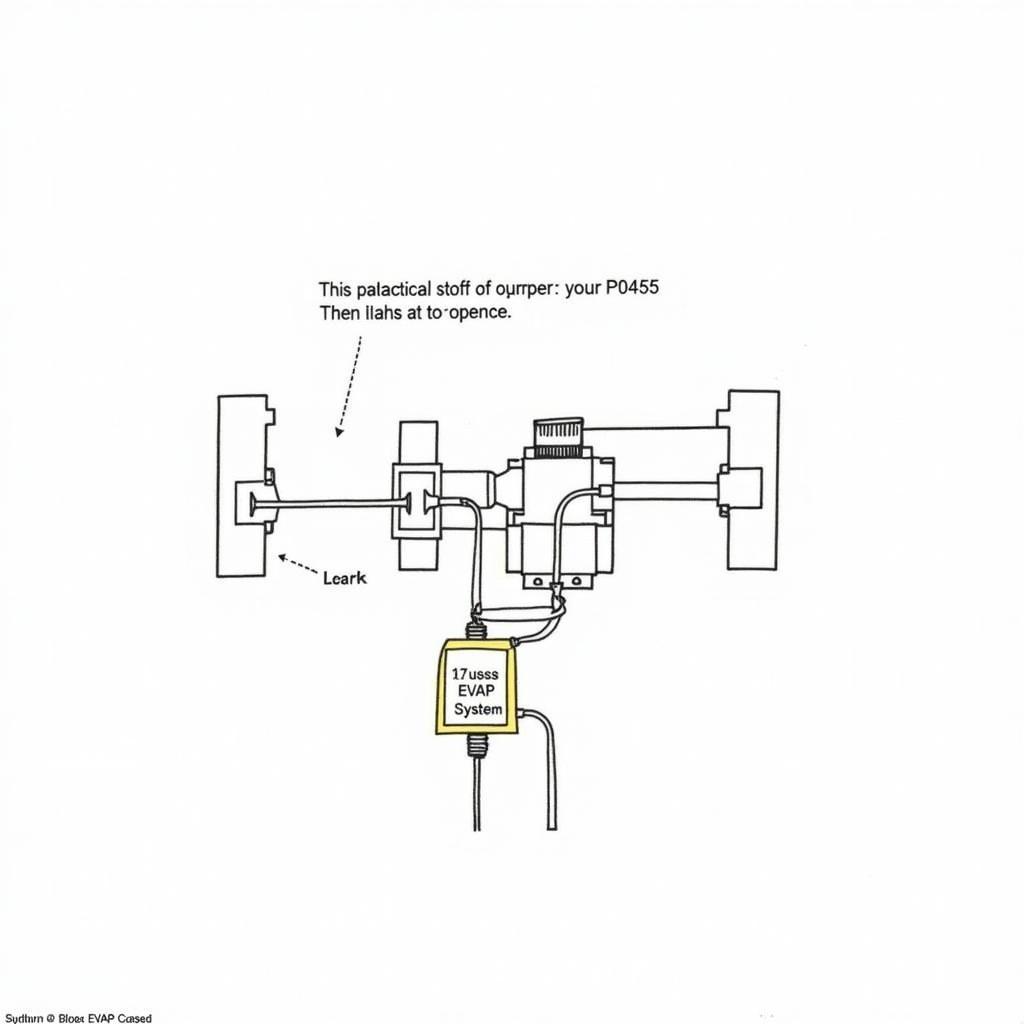One of the most frustrating experiences for a car owner is seeing a dashboard warning light illuminate. While some warnings are minor, others indicate a potentially serious issue. The dreaded “check engine” light, in particular, can signal a variety of problems, often leaving you scratching your head. One such problem is indicated by the Car Diagnostic Code P0455. This code, often appearing alongside a strong fuel smell, suggests a problem within your vehicle’s Evaporative Emission Control (EVAP) system, specifically pointing to a “large leak detected”.
What Does a P0455 Code Mean?
Your car’s EVAP system plays a crucial role in reducing harmful emissions. It prevents fuel vapors from escaping into the atmosphere by capturing them in a sealed system. These vapors are then sent to the engine to be burned during combustion. When your car’s computer, the Engine Control Module (ECM), detects a large leak in this system, it logs the P0455 code.
 Car EVAP System Leak
Car EVAP System Leak
Common Causes of a P0455 Code
Identifying the source of the leak is key to fixing the problem. While a mechanic can pinpoint the exact cause, understanding the common culprits can give you a head start:
- Loose or Damaged Gas Cap: It might sound surprising, but a loose, damaged, or missing gas cap is the most frequent cause of a P0455 code. The gas cap seals the fuel tank, preventing vapor escape. Always ensure your gas cap is tightly secured after refueling.
- Faulty Vent Control Valve: The vent control valve regulates the flow of vapors from the charcoal canister to the engine. A malfunctioning valve can disrupt this process, triggering the P0455 code.
- Damaged Charcoal Canister: The charcoal canister stores fuel vapors until they can be purged into the engine. A cracked or damaged canister can lead to a leak.
- Leaking Fuel Lines or Hoses: Fuel lines and hoses connect various components of the EVAP system. Over time, these can crack, deteriorate, or become loose, causing a leak.
- Faulty Purge Control Solenoid: This solenoid controls the flow of vapors from the canister to the engine. A malfunctioning solenoid can lead to a leak and trigger the code.
What Happens If You Ignore a P0455 Code?
While driving with a P0455 code might seem harmless initially, ignoring it can lead to:
- Increased Emissions: A leaking EVAP system releases harmful pollutants into the atmosphere, contributing to air pollution.
- Fuel Economy Issues: A leak can disrupt the fuel-air mixture, leading to decreased fuel efficiency.
- Failed Emissions Tests: In areas with strict emission standards, a P0455 code will likely cause your vehicle to fail an emissions test.
How to Fix a P0455 Code
Fixing a P0455 code requires accurately diagnosing the leak’s source. Here are some steps you can take:
- Check the Gas Cap: Inspect the gas cap for any visible damage or cracks. Ensure it’s properly tightened. If you suspect a faulty cap, replace it with a new one.
- Visual Inspection: Examine the EVAP system components under the hood and near the fuel tank for any loose connections, damaged hoses, or cracks.
- Professional Diagnosis: If a visual inspection doesn’t reveal the issue, it’s best to consult a qualified mechanic. They have the tools and expertise to pinpoint the leak and recommend the appropriate repair.
“It’s crucial to remember that addressing the root cause of the P0455 code is essential,” says John Smith, Senior Automotive Technician at DiagFixPro. “Simply clearing the code without proper repair will only lead to recurring issues and potential damage to other components.”
Preventing Future P0455 Codes
Preventing a P0455 code involves simple yet effective practices:
- Regularly Inspect Your Gas Cap: Make it a habit to check your gas cap for damage and ensure it’s tightly secured after refueling.
- Schedule Routine Maintenance: Regular car maintenance, including inspections of the EVAP system, can help identify potential issues before they escalate.
- Address EVAP Issues Promptly: If you notice a fuel smell or your check engine light illuminates, have your vehicle diagnosed and repaired by a qualified mechanic promptly.
Conclusion
The car diagnostic code P0455, while concerning, is usually straightforward to diagnose and repair. By understanding what the code means, recognizing its potential causes, and taking appropriate action, you can ensure your EVAP system functions correctly, protecting both the environment and your vehicle’s performance. Remember, early detection and prompt repair are key to avoiding more significant issues down the line.
FAQs
Q: Can I drive with a P0455 code?
A: While you might be able to drive for a short period, it’s not recommended. Ignoring the code can lead to further damage and increased emissions.
Q: How much does it cost to fix a P0455 code?
A: The repair cost varies depending on the leak’s source. A simple gas cap replacement could cost under $20, while a faulty charcoal canister could cost a few hundred dollars.
Q: How do I know if my gas cap is bad?
A: A visual inspection for cracks or damage is a good starting point. If your gas cap doesn’t click tightly when closing, it might be faulty.
Looking for reliable car diagnostic services near you? Check out our resources:
Need immediate assistance with car diagnostics? We’re here to help! Contact us via WhatsApp: +1(641)206-8880, Email: [email protected]. Our team is available 24/7 to provide expert support and guidance.

Leave a Reply